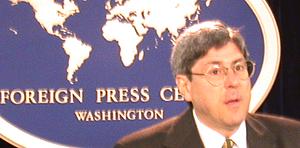RE Mark Byron
Heroic reader Lloyd sends this article about what happens to people who think the wrong thoughts aloud:
SIOUX FALLS, S.D. (AP) – A man who made a remark about a “burning Bush” during the president’s March 2001 trip to Sioux Falls was sentenced Friday to 37 months in prison.
Richard Humphreys of Portland, Ore., was convicted in September of threatening to kill or harm the president and said he plans to appeal. He has said the comment was a prophecy protected under his right to free speech.
Humphreys said he got into a barroom discussion in nearby Watertown with a truck driver. A bartender who overheard the conversation realized the president was to visit Sioux Falls the next day and told police Humphreys talked about a “burning Bush” and the possibility of someone pouring a flammable liquid on Bush and lighting it.
“I said God might speak to the world through a burning Bush,” Humphreys testified during his trial. “I had said that before and I thought it was funny.”
Not as funny as killing 50 Democrats and bystanders, apparently. Now that’s comedy.
Oh, That’s What They Meant by “Democracy”
Blogger Mark Byron–check him out on Glenn Reynolds’ blogroll— daydreams about building a Republican supermajority by assassinating 21 U.S. Senators, 5 Supreme Court justices, and a slew of bystanders. If only the warbloggers had told us that this is the sort of democracy they plan to impose on Iraq! Sounds feasible to me!
Oh, and while we’re indulging harmless fantasies, wouldn’t it be a hoot if a bunch of folks sent the Dept. of Homeland Security reports of Mr. Byron’s foray into creative writing? That would be a fun way to find out if all terror threats are considered equal. We all know those Bush administration softies would never abuse their new powers by punishing someone for thinking aloud.
PROOF! (of spin)
Big Story: Neocons Leak Neocon Memo, then Report On It
Today, Fox News anchors are repeatedly mentioning the blockbuster story “proving” a long-time link between Osama bin Laden and Saddam Hussein.
The leak was made to a truly unbiased source, the Weekly Standard. The neocon magazine titles the article on the “leaked” memo, “Case Closed.”
 The memo is from another unbiased source: Undersecretary of Defense for Policy Douglas J. Feith, one of the most hard-core neoconservatives at the Pentagon.
The memo is from another unbiased source: Undersecretary of Defense for Policy Douglas J. Feith, one of the most hard-core neoconservatives at the Pentagon.
At one point, a Fox reporter referred to the Weekly Standard as having “close ties to the White House.” You would think that they might mention that Fox and the Weekly Standard are both owned by Rupert Murdoch. Current and retired intel officers have identified the work of Feith’s Office of Special Plans as a key component of the exaggerated and manipulated intelligence produced on Iraq. Feith himself has been accused of being behind previous leaks of “raw intelligence.”
I wonder who “leaked” this memo to the Weekly Standard?
UPDATE: The Dept. of Defense has issued a news release dismissing the report.
US Death Toll Tops 400 (now 418)

Updated 11/15/03 6:50 pm EST:
The death toll hit 418 today, with the downing of two Black Hawk helicopters in Mosul, killing at least 17, and the death of another GI in a roadside bombing. While the Black Hawk crash appears to be the result of a collision, witnesses report the collision took place as one copter was moving to escape enemy fire and Reuters (UK) reports:
One of the helicopters was hit in the tail by a rocket propelled grenade (RPG), a U.S. officer at the scene said on Saturday.
Central Command reports another death of a US soldier in Iraq:
- BAGHDAD, Iraq – A 1st Armored Division soldier died of wounds received when the convoy in which the soldier was riding struck an improvised explosive device (IED) approximately 8:20 a.m., Nov. 14, near central Baghdad.
The convoy was conducting a mounted patrol when it struck the IED. The deceased soldier was medically evacuated to the 28th Combat Support Hospital, along with two other soldiers who received shrapnel wounds. At the 28th CSH, the soldier died of wounds this evening.
This death brings the US total to 400. As reported elsewhere, the death toll has surpassed that of the first three years of Vietnam and with Bush’s recent pronouncement that US troops would remain in Iraq until they capture or kill the “evildoers,” it is clear the that list of dead will only continue to increase. The president’s words indicate that the real threat — bin Laden — has been conveniently forgotten and relegated for more “pressing” ends:
- “We are not pulling out until the job is done – period,” Mr Bush said.
Asked whether that included finding Saddam Hussein and bin Laden, Mr Bush said: “Yes, that’s part of it. But even bigger is a free and democratic society. That is the mission.”
If you would like to remind the world of the real cost of this never-ending war and fruitless crusade for world democracy, place a Antiwar.com casualty counter (see top right of this page) on your website. It is fairly easy:
1. Download this file and this file and place them in the same folder as the page that will display the counter.
2. Insert the code below where you want the counter to display:
Napoleon, Bismarck, Hitler… Bush?
 Frederick W. Kagan, author, and teacher of military history at West Point, is a tax-and-spend hegemonist. In “The art of war,” an article from the November, 2003, The New Criterion, which I found on the excellent aldaily.com site, Kagan warns about the dangers of the “search for ‘efficiency’ in military affairs.” Rather than an efficient military, see, the US needs a massive military with intentional redundancy in equipment and functions. Or is he arguing that military defense is possible and inexpensive but world hegemony is expensive in blood and treasure — and futile to boot?
Frederick W. Kagan, author, and teacher of military history at West Point, is a tax-and-spend hegemonist. In “The art of war,” an article from the November, 2003, The New Criterion, which I found on the excellent aldaily.com site, Kagan warns about the dangers of the “search for ‘efficiency’ in military affairs.” Rather than an efficient military, see, the US needs a massive military with intentional redundancy in equipment and functions. Or is he arguing that military defense is possible and inexpensive but world hegemony is expensive in blood and treasure — and futile to boot?
Excerpts:
In each of the periods in recent history in which one might see a fundamental change in the nature of war, it is true that normally one state begins with a dramatic lead. Revolutionary France’s ability in the 1790s to mobilize vast conscript armies and to sustain that mobilization for years gave her an important advantage over continental states unable to match such levels of mobilization. Prussia’s early and enthusiastic development of a dense railroad net and of the general staff structure needed to plan for and control a railroad mobilization led directly to her crushing victories over Austria in 1866 and over France in 1871. The Nazis’ creation of a technologically advanced and highly trained armored force, along with a significantly better armored warfare doctrine, led directly to the destruction of the Franco-British army in 1940.
In each case, however, we must also consider the sequel. Napoleonic France, Imperial Germany, and Nazi Germany all ultimately lost subsequent wars and were destroyed. The reasons for those failures are enlightening about the limitations of the current definition of revolution in military affairs. …
History so far, therefore, has been very clear that “asymmetrical advantages” gained by one state do not normally last very long. Technology and technique inevitably spreads. Other states acquire either similar or counteracting capabilities. The final victors of each new “revolutionary” epoch have not usually been the states that initiated the revolution, but those that responded best once the technologies and techniques had become common property.
It also shows that the initial successes those “revolutionary” states achieved have tended to breed arrogance and overconfidence, hindering their ability to respond as other states began to match their capabilities. Napoleonic France, Imperial Germany, and Nazi Germany all ossified in their techniques after the initial victories, and lost to enemies who, forced by defeat, built on their own advances more successfully.
The search for an indefinite American “asymmetrical advantage,” therefore, requires not merely a revolution in military affairs: it also requires a fundamental revolution in human affairs of a sort never seen before. It requires that America continue to change her armed forces so rapidly and successfully that no other state can ever catch up—indeed, that no other state in the world even try.
…[F]ew if any of America’s enemies will have the vast resource-stretching responsibilities that America has. They will be concerned only with their own region of the world and will focus their efforts on developing communications and target tracking systems only over a small portion of the globe. They will not need a dense global satellite constellation or the ability to project power over thousands of miles. The costs to them of developing systems comparable to America’s, but only in a restricted geographic area, will accordingly be much smaller than the price the U.S. has had to pay to achieve that capability everywhere.
Then, too, other states can reap the benefits of modern communications systems without bearing the expensive burden of basic scientific research and development. Microprocessors, satellites, encrypted laser communications systems, cell phone systems, and the whole host of technologies that form the basis of American military superiority are now the property of the world. It will not cost America’s enemies anything like what it cost the U.S. to develop its capabilities, either in money or in time. Since technology inevitably becomes less expensive as it proliferates and as time goes on, moreover, the situation for America’s would-be adversaries will only improve in this regard. …
When America’s enemies have developed the technology and trained the people who will use it, they will also have to develop the doctrines and techniques to make it effective. In this regard, they have the most significant advantage of all. Much of America’s tested doctrine has been published, much can be deduced from the CNN coverage of America’s most recent wars. Once again, America’s enemies can start from the position of proven success that the U.S. armed forces achieved, and build from there.
Their real advantage in this area, however, results from the fact that they will be developing armed forces specifically designed to fight an enemy with the same capabilities. America’s military has not done so. American military doctrine continues to foresee fighting enemies lacking any significant capacity to deploy precision guided munitions, without dense satellite constellations and communications systems, and without the ability to strike targets precisely at great distances. It is one of the more troubling lessons of the history of new military technology that the states that pioneer the new technologies and techniques generally fail to adapt successfully to the situation in which all major states have the same technologies and techniques. It remains to be seen whether America will do any better than her predecessors in this regard.




